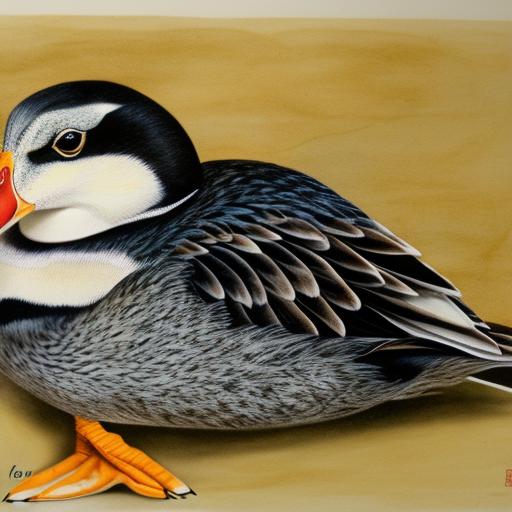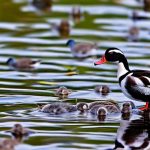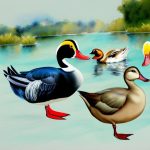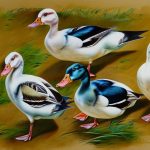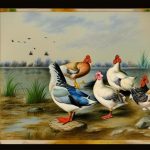Black wild duck breeds are a fascinating and diverse group of waterfowl that have captured the attention of bird enthusiasts and conservationists alike. These ducks are known for their striking black plumage, which sets them apart from other duck species. They can be found in a variety of habitats, from marshes and wetlands to rivers and lakes, and are known for their adaptability and resilience in the wild. Black wild duck breeds are not only beautiful to look at, but they also play a crucial role in maintaining the ecological balance of their habitats. In this article, we will explore the characteristics, popular breeds, habitat and behavior, conservation efforts, breeding and rearing, as well as the challenges facing black wild duck breeds.
Key Takeaways
- Black wild duck breeds are known for their unique and striking appearance, making them a popular choice for breeders and enthusiasts.
- These ducks are characterized by their glossy black plumage, often with iridescent green or purple hues, and their distinctive beak and feet colors.
- Some popular black wild duck breeds include the Cayuga, East Indian, and Black Swedish, each with their own unique traits and characteristics.
- Black wild duck breeds are typically found in wetland habitats, where they exhibit natural behaviors such as foraging for food and nesting in secluded areas.
- Conservation efforts for black wild duck breeds are important to ensure their survival, as they face challenges such as habitat loss and competition from invasive species.
Characteristics of Black Wild Duck Breeds
Black wild duck breeds are characterized by their glossy black plumage, which can have a green or purple iridescence in certain lighting conditions. Their bills are typically a dark color, and their legs and feet are often a dull orange or yellow. These ducks are medium-sized, with a streamlined body and a slightly elongated neck. They have a distinctive upright posture and are known for their graceful swimming and diving abilities. Black wild duck breeds are also known for their strong and agile flight, making them adept at navigating through their natural habitats. In terms of behavior, these ducks are generally social animals, often forming flocks during migration or when foraging for food. They are also known for their distinctive vocalizations, which can range from soft quacks to loud calls, depending on the situation. Overall, black wild duck breeds are a unique and captivating group of waterfowl with a range of physical and behavioral characteristics that make them stand out in the avian world.
Popular Black Wild Duck Breeds
There are several popular black wild duck breeds that are well-known among bird enthusiasts and conservationists. One of the most iconic black duck breeds is the American Black Duck, which is native to North America and is known for its striking black plumage with a contrasting light-colored bill. Another popular breed is the East Indies duck, which is a small domesticated breed that closely resembles its wild counterparts with its glossy black feathers and upright posture. The Cayuga duck is another well-known black breed, named after Cayuga Lake in New York where it was first bred. This breed is prized for its iridescent greenish-black plumage and calm temperament. The Swedish Black duck is also a popular breed, known for its solid black plumage and excellent egg-laying abilities. These are just a few examples of the many black wild duck breeds that have captured the interest of bird enthusiasts around the world.
Habitat and Behavior of Black Wild Duck Breeds
Black wild duck breeds can be found in a variety of habitats, including marshes, wetlands, rivers, lakes, and coastal areas. They are highly adaptable and can thrive in both freshwater and saltwater environments. These ducks are often found in areas with abundant vegetation and food sources, such as aquatic plants, insects, small fish, and crustaceans. In terms of behavior, black wild duck breeds are generally social animals that form flocks during migration or when foraging for food. They are also known for their courtship displays, which can involve elaborate behaviors such as head bobbing, wing flapping, and vocalizations. During the breeding season, these ducks will build nests in secluded areas near water and lay a clutch of eggs. Once the eggs hatch, the ducklings are cared for by the mother until they are old enough to fend for themselves. Overall, black wild duck breeds exhibit a range of fascinating behaviors that make them a joy to observe in their natural habitats.
Conservation Efforts for Black Wild Duck Breeds
Conservation efforts for black wild duck breeds are crucial in ensuring the survival of these beautiful and ecologically important birds. Habitat loss, pollution, hunting, and climate change are some of the major threats facing these ducks, making conservation efforts all the more urgent. Organizations such as Ducks Unlimited and the National Audubon Society have been instrumental in protecting and restoring wetland habitats that are vital for black wild duck populations. These efforts include habitat restoration projects, conservation easements, and public education initiatives to raise awareness about the importance of preserving wetlands for waterfowl. In addition to habitat conservation, efforts to regulate hunting and implement sustainable management practices have also been key in protecting black wild duck populations. By working together to address these threats, conservationists can help ensure that black wild duck breeds continue to thrive in their natural habitats for generations to come.
Breeding and Rearing Black Wild Duck Breeds

Breeding and rearing black wild duck breeds can be a rewarding experience for bird enthusiasts and conservationists alike. When breeding these ducks in captivity, it is important to provide them with a suitable environment that mimics their natural habitat, including access to water for swimming and foraging. Nesting boxes or shelters should also be provided to give the ducks a safe place to lay their eggs and raise their young. When it comes to rearing ducklings, it is important to provide them with a balanced diet that includes commercial waterfowl feed as well as access to natural foods such as insects and aquatic plants. Proper care should also be taken to ensure that the ducklings have access to clean water for drinking and bathing. By following best practices for breeding and rearing black wild duck breeds, individuals can contribute to the conservation of these birds while also enjoying the unique experience of raising them in a captive setting.
Challenges Facing Black Wild Duck Breeds
Despite their adaptability and resilience, black wild duck breeds face a number of challenges that threaten their survival in the wild. Habitat loss due to urban development, agriculture, and industrial pollution is one of the biggest threats facing these ducks. Wetland destruction and degradation also pose significant challenges for black wild duck populations, as these habitats are crucial for their breeding, feeding, and resting needs. In addition to habitat loss, hunting pressure remains a concern for many black wild duck breeds, particularly in areas where they are sought after for their meat or feathers. Climate change is another major threat facing these ducks, as it can lead to changes in weather patterns, sea level rise, and shifts in vegetation that can impact their natural habitats. By addressing these challenges through habitat conservation, sustainable management practices, and public education efforts, we can work towards ensuring a brighter future for black wild duck breeds in the wild.
In conclusion, black wild duck breeds are a fascinating group of waterfowl with unique characteristics and behaviors that make them a joy to observe in their natural habitats. From their striking black plumage to their graceful swimming and diving abilities, these ducks have captured the attention of bird enthusiasts around the world. However, they face a number of challenges that threaten their survival, making conservation efforts all the more crucial in ensuring their continued existence in the wild. By working together to address these threats through habitat conservation, sustainable management practices, and public education initiatives, we can help protect these beautiful birds for future generations to enjoy. Whether it’s through observing them in the wild or raising them in captivity, black wild duck breeds will continue to inspire awe and admiration for years to come.
If you’re interested in learning more about how to care for your black wild duck breeds, you might also want to check out this helpful article on how to insulate a chicken coop. Proper insulation is essential for keeping your ducks comfortable and healthy, especially during colder months. This article provides valuable tips and techniques for ensuring your coop is well-insulated, creating a cozy environment for your feathered friends.
FAQs
What are black wild duck breeds?
Black wild duck breeds are a type of duck that have predominantly black plumage. They can be found in various regions around the world and are known for their striking appearance.
What are some examples of black wild duck breeds?
Some examples of black wild duck breeds include the Black East Indie, Cayuga, and Swedish Black ducks. These breeds are known for their dark plumage and are often kept for their ornamental value.
What is the behavior of black wild duck breeds?
Black wild duck breeds exhibit similar behavior to other duck breeds. They are typically social animals that prefer to live in groups and are known for their foraging and swimming abilities.
What do black wild duck breeds eat?
Black wild duck breeds are omnivorous and will eat a variety of foods including aquatic plants, insects, small fish, and grains. They are also known to forage for food in fields and grassy areas.
Are black wild duck breeds good for domestication?
Yes, black wild duck breeds are often domesticated and kept for ornamental purposes. They are relatively easy to care for and can adapt well to various environments.
Meet Walter, the feathered-friend fanatic of Florida! Nestled in the sunshine state, Walter struts through life with his feathered companions, clucking his way to happiness. With a coop that’s fancier than a five-star hotel, he’s the Don Juan of the chicken world. When he’s not teaching his hens to do the cha-cha, you’ll find him in a heated debate with his prized rooster, Sir Clucks-a-Lot. Walter’s poultry passion is no yolk; he’s the sunny-side-up guy you never knew you needed in your flock of friends!

